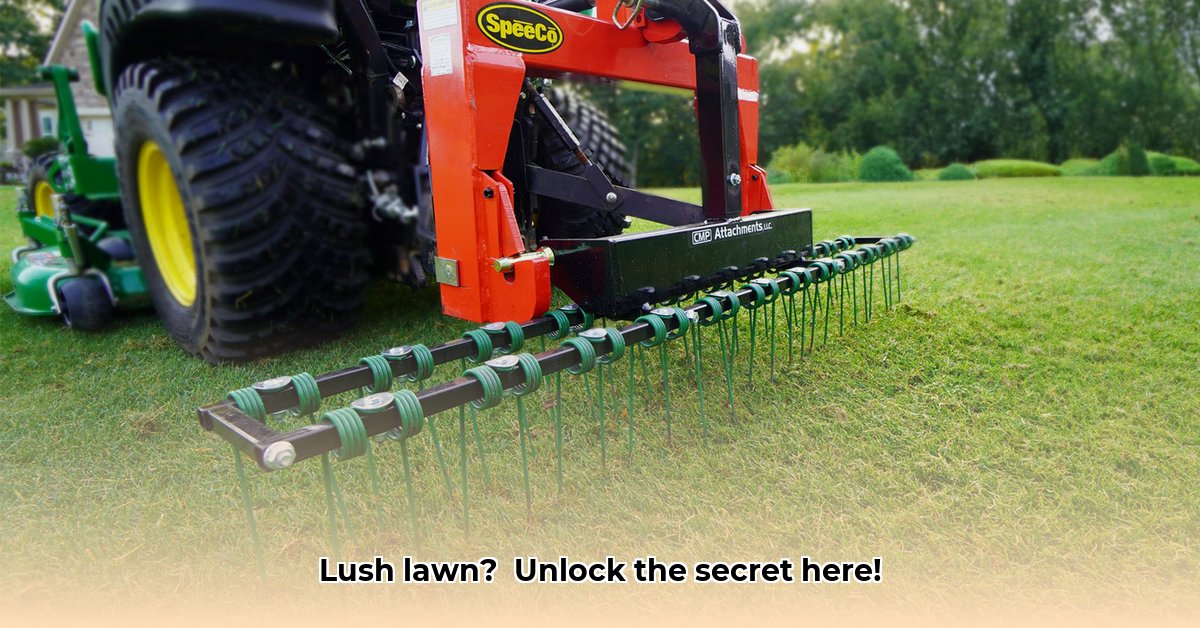
Why Dethatch Your Lawn? The Path to a Healthier, Eco-Friendly Paradise
A thick layer of thatch—a mat of dead grass, stems, and roots—stifles your lawn's growth. It prevents water, air, and essential nutrients from reaching the soil, leaving your grass vulnerable to disease and pests. Think of it like a suffocating blanket! Dethatching, the process of removing this thatch, is essential for healthy, vibrant turf. But it’s more than just aesthetics; dethatching promotes a more sustainable lawn. By improving air and water penetration, you dramatically reduce the need for excessive watering and fertilization, saving you money and resources. Isn't a healthier lawn also a more environmentally friendly lawn? For tractor-mounted options, check out tractor dethatchers.
Choosing Your Dethatching Weapon: A Comparison of Options
Several types of dethatchers cater to different needs and lawn sizes. Let's explore the best options for your sustainable lawn care approach:
1. Manual Dethatchers: The Eco-Friendly, Budget-Conscious Choice
Manual dethatchers are the most affordable and environmentally friendly option, perfect for small lawns. They require only your manual labor and minimal environmental impact. However, they're labor-intensive and unsuitable for larger areas or thick thatch.
2. Electric Dethatchers: Power and Quiet Efficiency Combined
Electric dethatchers provide a balance between power and environmental responsibility. They're quieter and produce zero direct emissions, making them a greener choice than gas-powered models. However, their power might not suffice for very large lawns or exceptionally thick thatch. Cord management also presents a slight inconvenience.
3. Gas-Powered Dethatchers: Muscle for the Massive Lawns
For large lawns needing heavy-duty dethatching, gas-powered models offer unmatched power and efficiency. However, these powerful machines come with noise pollution and harmful emissions, significantly impacting their environmental friendliness. Proper fuel disposal adds another layer of responsibility.
4. Lawn Tractor Dethatchers: Efficiency Redefined
Attaching a dethatcher to your lawn tractor provides unparalleled efficiency, particularly for larger areas. The speed and thoroughness maximize your time, and reduce the physical exertion compared to manual methods. While the initial investment is higher (requiring a lawn tractor), the time savings and efficiency for larger lawns make it a worthwhile consideration.
| Dethatcher Type | Pros | Cons | Environmental Impact |
|---|---|---|---|
| Manual | Affordable, eco-friendly, low maintenance | Time-consuming, limited reach | Minimal |
| Electric | Quiet, clean, zero emissions | Less powerful, cord limitations | Low |
| Gas-Powered | Powerful, efficient for large areas | Noisy, air pollution, fuel disposal concerns | Moderate to High |
| Lawn Tractor Dethatcher | Fast, efficient, less physical effort | Requires tractor, higher initial investment | Moderate (depends on tractor engine) |
Selecting the Right Dethatcher: A Personalized Approach
Choosing the best dethatcher involves assessing several critical factors:
Lawn Size: For small lawns (under 500 sq ft), a manual dethatcher might suffice. Larger lawns benefit from the efficiency of electric, gas-powered, or tractor-mounted dethatchers.
Thatch Thickness: A thin layer of thatch (< ½ inch) might be manageable with a rake. Thicker layers necessitate a more powerful dethatcher.
Budget: Manual dethatchers are the most affordable, while lawn tractor dethatchers represent the highest initial investment. Electric and gas-powered models fall between these extremes.
Environmental Considerations: If minimizing your environmental footprint is paramount, prioritize electric or manual dethatchers.
Carefully weigh these factors to select the ideal dethatcher for your lawn and your environmental priorities.
Dethatching with Your Lawn Tractor Dethatcher: A Step-by-Step Guide
Preparation: Mow your lawn to a medium height (3-4 inches) a day or two before dethatching. Clear away any large debris to prevent damage.
Attachment: Securely attach the dethatcher to your lawn tractor, following the manufacturer's instructions meticulously. Safety is paramount.
Depth Adjustment: Adjust the dethatching depth; begin shallow and increase as needed. Avoid over-dethatching, which can damage your grass.
Overlapping Passes: Drive your tractor in overlapping passes, ensuring complete coverage of your lawn. Aim for approximately 50% overlap for thorough thatch removal.
Post-Dethatching Cleanup: Gather the removed thatch using a rake or leaf blower.
Sustainable Thatch Management: Minimizing Waste, Maximizing Benefits
Do not discard removed thatch carelessly; it's valuable organic matter! Composting it enriches your soil and reduces landfill waste. Alternatively, use it as mulch in other garden areas.
Maintaining Your Dethatcher: Extending Lifespan, Reducing Waste
Regular maintenance prolongs your dethatcher's lifespan, minimizing waste and maximizing your investment. Clean it thoroughly after each use, and lubricate according to the manufacturer's instructions. Proper storage protects it from the elements.
Key Takeaways: Achieving a Lush, Sustainable Lawn
- Excessive thatch harms your lawn, hindering growth and promoting disease. Dethatching significantly improves water and nutrient absorption.
- Several dethatching options exist, each with unique environmental impacts, and suitability for varying lawn sizes.
- Choosing the right dethatcher involves considering lawn size, budget, and personal environmental priorities.
- Sustainable thatch disposal methods, like composting, minimize waste and enrich your soil.
- Regular dethatcher maintenance extends its lifespan, reduces waste, and ensures optimal performance.